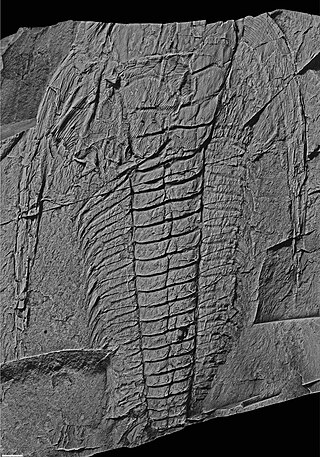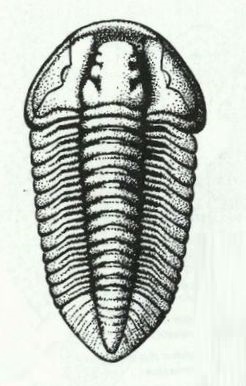
Trilobites are extinct marine arthropods that form the class Trilobita. Trilobites form one of the earliest known groups of arthropods. The first appearance of trilobites in the fossil record defines the base of the Atdabanian stage of the Early Cambrian period and they flourished throughout the lower Paleozoic before slipping into a long decline, when, during the Devonian, all trilobite orders except the Proetida died out. The last trilobites disappeared in the mass extinction at the end of the Permian about 251.9 million years ago. Trilobites were among the most successful of all early animals, existing in oceans for almost 270 million years, with over 22,000 species having been described.

John William Salter was an English naturalist, geologist, and palaeontologist.

Phacops is a genus of trilobites in the order Phacopida, family Phacopidae, that lived in Europe, northwestern Africa, North and South America and China from the Late Ordovician until the very end of the Devonian, with a broader time range described from the Late Ordovician. It was a rounded animal, with a globose head and large eyes, and probably fed on detritus. Phacops is often found rolled up ("volvation"), a biological defense mechanism that is widespread among smaller trilobites but further perfected in this genus.

Flexicalymene Shirley, 1936. is a genus of trilobites belonging to the order Phacopida, suborder Calymenina and Family Calymenidae. Flexicalymene specimens can be mistaken for Calymene, Gravicalymene, Diacalymene and a few other Calymenina genera. They are used as an index fossil in the Ordovician. Ohio and North America are particularly known for being rich with Flexicalymene fossils.

Gravicalymene Shirley, 1936, is a genus of trilobites belonging to the order Phacopida, suborder Calymenina and family Calymenidae. Species included in this genus have previously been allocated to Calymene Brongniart 1822,Flexicalymene Shirley, 1936. and Sthenarocalymene Siveter 1977.

Calymene blumenbachii Brongniart in Desmarest (1817), sometimes erroneously spelled blumenbachi, is a species of trilobite discovered in the limestone quarries of the Wren's Nest in Dudley, England. Nicknamed the Dudley Bug or Dudley Locust by 18th-century quarrymen it became a symbol of the town and featured on the Dudley County Borough Council coat-of-arms. Calymene blumenbachii is commonly found in Silurian rocks and is thought to have lived in the shallow waters of the Silurian, in low-energy reefs. This particular species of Calymene is unique to the Wenlock series in England, and comes from the Wenlock Limestone Formation in Much Wenlock and the Wren's Nest in Dudley. These sites seem to yield trilobites more readily than any other areas on the Wenlock Edge, and the rock here is dark grey as opposed to yellowish or whitish as it appears on other parts of the Edge, just a few miles away, in Church Stretton and elsewhere. This suggests local changes in the environment in which the rock was deposited.

Balizoma is a genus of trilobites from the family Encrinuridae established by David J. Holloway in 1980. It has only been found in rocks of Silurian age. Its type species, B. variolaris, is currently the only named species of the genus, and is found in England. The neotype of B. variolaris was collected from the Much Wenlock Limestone Formation at Dudley, West Midlands. That specimen was first illustrated in Sir Roderick Impey Murchison's classic book, The Silurian System. B. variolaris was the original "strawberry-headed" trilobite of Dudley, so-named because of its nodular glabellar tubercles, and well known to early trilobite collectors. Additional species were originally assigned to Balizoma, but were subsequently placed in other encrinurine genera.

Charles Stokes was a London stockbroker who gained a reputation both as an amateur scientist and as an art collector.








